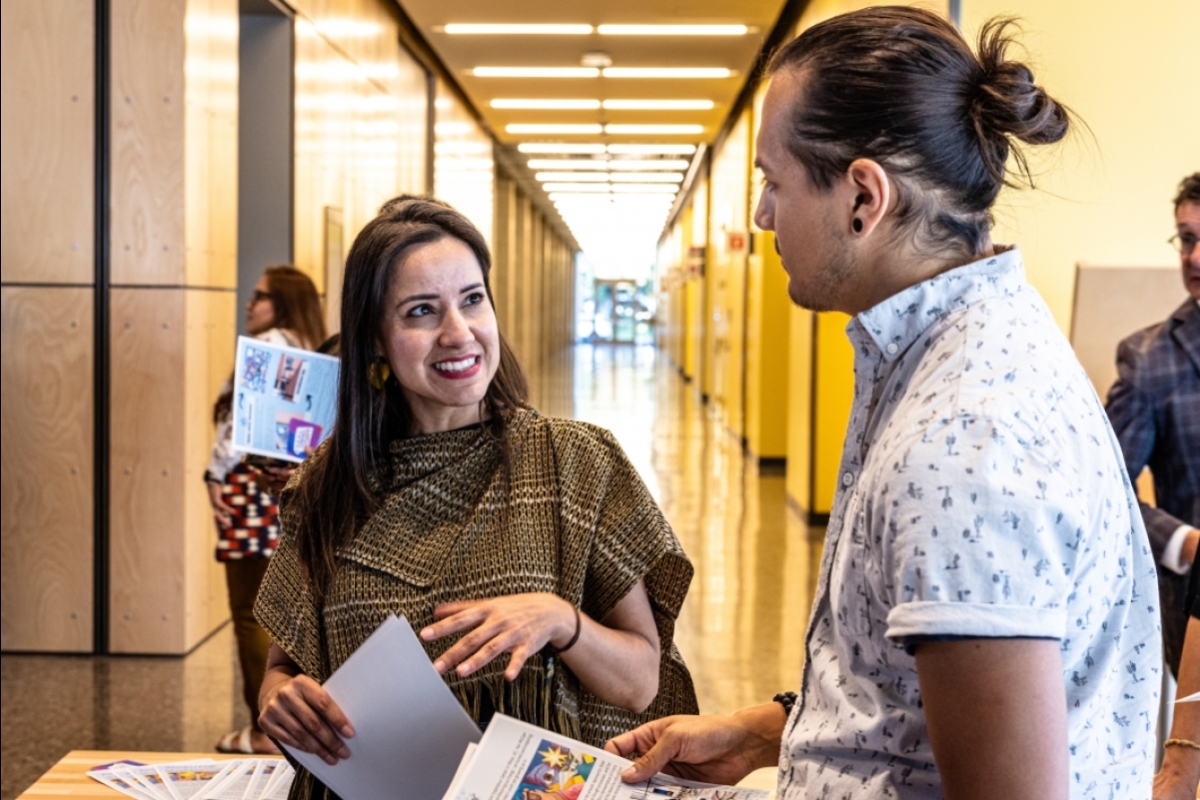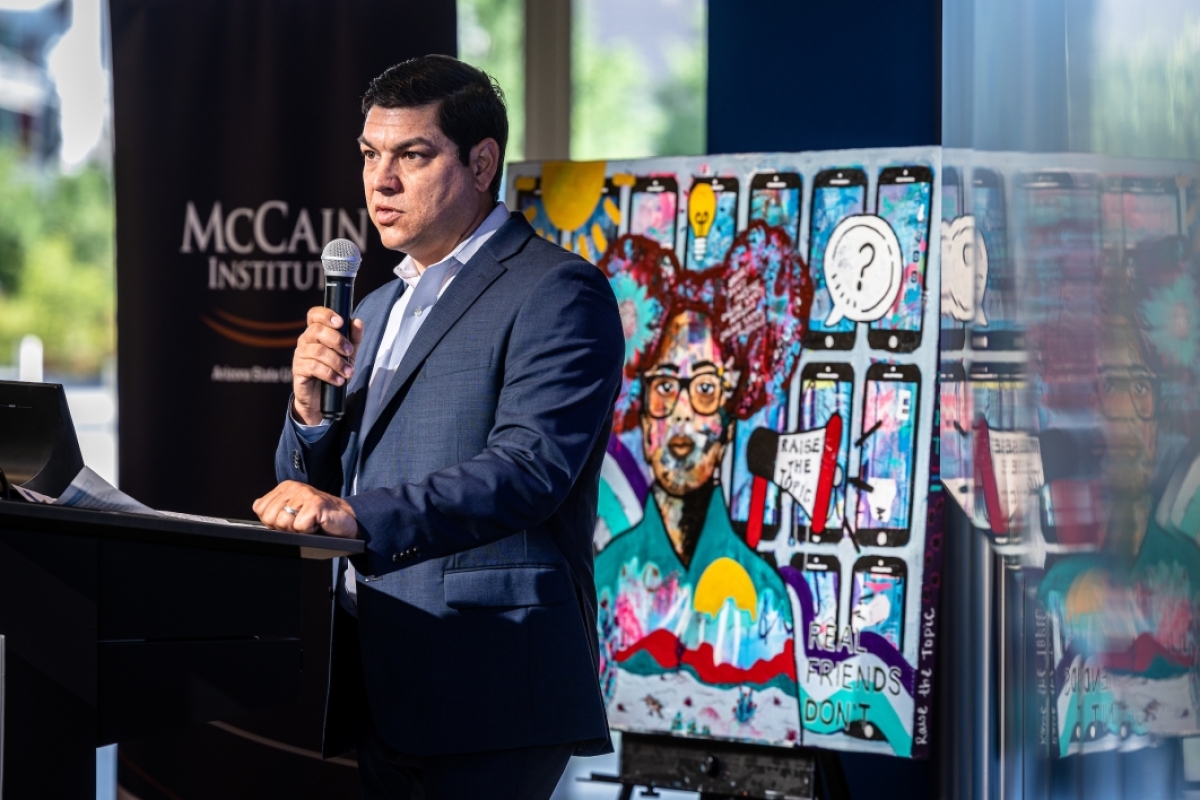Two artworks with a message of support and safety for young people were unveiled on Wednesday at the Media and Immersive eXperience (MIX) Center in downtown Mesa.
The pieces, a mixed-media collage and a digital mural in the MIX Center’s lobby, were part of a campaign by the McCain Institute at Arizona State University to prevent online exploitation of children and teens.
Both works were created through a collaboration of local artists and youth organizations in Mesa to incorporate the messaging of the R.E.A.L. Friends Don’t campaign by the Combatting Human Trafficking program in the McCain Institute.
The digital mural, titled “Restoring Our Energy,” (seen above) was created by two artists from the Xico Inc. art collective, Diana Calderon and Martin Moreno, working with young people from the one•n•ten center for LGBTQ youth.
The mixed-media canvas, called “I AM Online Safety Awesome,” was done by artist Tiesha Harrison in collaboration with young people from the Boys & Girls Club in Mesa.
Artist Tiesha Harrison stands in front of the mixed-media piece she worked on titled "I AM Online Safety Awesome" during an unveiling at the MIX Center in downtown Mesa on May 3. Photo by Charlie Leight/ASU News
The Combatting Human Trafficking program started the R.E.A.L. Friends Don’t campaign in 2020 to give parents and young people information to deal with online exploitation, which increased during the pandemic due to kids’ increased time online. It stands for:
• Raise the topic of online safety with your kids.
• Educate yourself on the technology they’re using.
• Act if something makes you or your child uncomfortable.
• Learn all you can. Stay involved and stay alert.
The artworks were designed to not only appeal to the eye, but also to start a conversation about a topic that is often avoided, according to Kelsey Syms, program manager for Combatting Human Trafficking. She said the campaign goal is to provide action-oriented solutions to online child exploitation.
“As COVID was taking over, parents and caregivers were overwhelmed with not only how to adapt to the pandemic but also to have kids at home with virtual learning,” she said.
“We wanted to put out an awareness campaign to educate parents about four actionable steps they can take tonight at the dinner table.”
At the unveiling event on Wednesday, Syms said that online exploitation is the fastest growing form of violence against children. Yet a recent McCain Institute study found that less than half of caregivers had talked to their children about the risks.
The R.E.A.L. acronym emphasizes the point that discussing online safety is not a one-time conversation, Syms said.
“The second piece of the title is for parents to begin the conversation that, ‘Real friends don’t pretend to be someone they’re not,’ or ‘Real friends don’t ask for sexually explicit images.’'”
The campaign was promoted on digital platforms and social media in English and Spanish, and was also featured on billboards in several cities in Texas during the summer of 2021.
“We were trying to reach caregivers as they were driving to work or school to facilitate that conversation,” Syms said.
The Combatting Human Trafficking program worked with several partners to develop the messaging, including the National Center for Missing and Exploited Children and the Polaris Project.
Feedback from parents and caregivers was good, and in summer 2021, the campaign was expanded to reach young people directly.
“Teens are resilient and informed and need to keep themselves and their peers safe,” she said, noting that Black, Latino and LGBTQ youth are more likely to be targeted.
The messaging for young people includes information such as “Realize that predators pretend to be your friend” or “By the time they ask you for something personal, it might not seem creepy. This is part of their trick called grooming.” The web page also includes a step-by-step guide of what to do if explicit photos have already been shared or leaked.
But the institute wanted to go beyond digital messaging.
“We’ve seen the power that art can have in sparking conversations, and it’s a compelling way to share information,” Syms said.
So the program did a pilot in Chicago, working with mural artists to develop design workshops with young people.
“We left it to the artists and youths to design a piece of art that resonated with them and that they wanted to see in their community.”
The result was a 60-foot mural that’s still up in a Chicago neighborhood.
Because the McCain Institute is based at ASU, the program wanted to work in an Arizona community with local artists and young peoples’ organizations.
Harrison graduated from ASU with a degree in interdisciplinary studies and found her path to art when she interned for a fashion designer. She’s volunteered her skills for several causes, including Free Arts for Abused Children and the Special Olympics.
She’s now a full-time artist who creates art-immersive experiences under her business I Am Undefined Art.
When collaborating with the Boys & Girls Club youths, Harrison had them draw a storyboard incorporating some of the R.E.A.L. Friends Don’t messaging. Then she used their imagery in her mixed-media piece.
“There was a student that sat the whole time and didn’t really paint or draw and I told her, ‘Your voice is important.’
“I walked her through and made sure she drew one thing, and she waited until everyone left and came up and said, ‘I’m not sure this is good’ and I told her I would definitely include it.
“That lightened my soul,” said Harrison, whose piece was displayed at Gammage before being moved to the MIX Center.
The other artists, Calderon and Moreno of the Xico Inc. organization, had collaborated many times.
“This project seemed like a good fit. We’re both educators and like to utilize art as a healing mechanism for communities,” Moreno said.
They worked with young people from the one•n•ten center for LGBTQ youths in Mesa.
“We were there to guide them and teach them basic painting techniques. They did all the painting and we just came in and defined some areas,” he said.
“I’ve been a muralist for 45 years now, and it’s always been my philosophy that art should be available to the whole community, regardless of who you are or where you are economically or geographically,” Moreno said.
Calderon said that she and Moreno had the young people discuss what kind of symbolic imagery they wanted on the mural.
“We wrote words on a dry erase board and talked about how to put our thoughts into symbols,” she said.
“We spoke about making something positive out of negativity and being open to growing, seeking wisdom and mentoring.”
The teens talked about ways to recharge their energy — hobbies, listening to music, enjoying nature, breathing and meditation.
“There are symbols like flowers for nature and wings for freedom. There’s an aspect of stained glass for restoration — a metaphor for making something beautiful out of broken pieces,” she said.
The original mural, 16 feet long by 3 feet high in vibrant shades of blue, pink and purple, was photographed and projected digitally onto the 32-foot screen in the lobby of the MIX Center.
The mural "Restoring our Energy" is digitally displayed in the lobby of the MIX Center in downtown Mesa on May 3. Composite photo by Charlie Leight/ASU News
Hira Ismail, the training and digital program specialist for one•n•ten, said she loves when the young people have a chance to interact with other organizations.
“We want them to walk in the world feeling confident about themselves and I could see that happening here,” she said.
“I loved that they felt they could have those conversations and this space was still safe with the artists.”
Josh Stine, vice president of external affairs and business partnerships for Boys & Girls Clubs of the Valley, said that his organization wants to make sure its young people are prepared.
“We see the positive and negative impact of social media and access to technology to youth and teens today and the influence it has on some of the decision-making,” he said, noting that the clubs provide programming for young people on the risks of social media and technology.
“A project like this gives them a way to be proactive and to be ambassadors for other youth and teens on how to protect themselves,” he said.
The Combatting Human Trafficking program recently received funding to evaluate the effectiveness of its campaigns on shifting behavior.
“We’re really excited about this,” Syms said. “It’s a huge opportunity to learn if these types of campaigns are effective or if we need to identify new or different approaches to reach those most vulnerable to trafficking and exploitation.”
Evelyn Farkas, executive director of the McCain Institute, said, “The McCain Institute is proud to be part of the Arizona State University community and deeply values our Arizona-based partners who have worked with us on this meaningful endeavor.
“Public art serves as a critical stimulus for the challenging, but necessary, conversations we need to have about the online safety of our children.”
Top photo: Patrons socialize in front of a digitally displayed mural titled "Restoring our Energy" at the R.E.A.L Friends Don’t public art unveiling on Wednesday, May 3, at the MIX Center in downtown Mesa. Photo by Charlie Leight/ASU News
More Arts, humanities and education

Upcoming exhibition brings experimental art and more to the West Valley campus
Ask Tra Bouscaren how he got into art and his answer is simple.“Art saved my life when I was 19,” he says. “I was in a dark place and art showed me the way out.”Bouscaren is an …

ASU professor, alum named Yamaha '40 Under 40' outstanding music educators
A music career conference that connects college students with such industry leaders as Timbaland. A K–12 program that incorporates technology into music so that students are using digital tools to…

ASU's Poitier Film School to host master classes, screening series with visionary filmmakers
Rodrigo Reyes, the acclaimed Mexican American filmmaker and Guggenheim Fellow whose 2022 documentary “Sansón and Me” won the Best Film Award at Sheffield DocFest, has built his career with films that…









